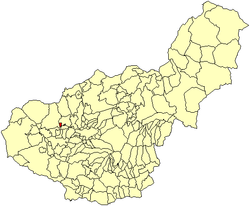You can help expand this article with text translated from the corresponding article in Spanish. (March 2016)Click [show] for important translation instructions.
|
This article needs additional citations for verification .(May 2024) |
Valderrubio | |
|---|---|
 | |
 Location of Valderrubio | |
| Coordinates: 37°14′04″N3°49′25″W / 37.23444°N 3.82361°W | |
| Country | |
| Province | |
| Comarca | Vega de Granada |
| Judicial district | Granada |
| Government | |
| • Mayor | Francisca Blanco Martín (PSOE) |
| Area | |
• Total | 6.59 km2 (2.54 sq mi) |
| Elevation | 550 m (1,800 ft) |
| Population (2018) [1] | |
• Total | 2,086 |
| • Density | 320/km2 (820/sq mi) |
| Demonym | valderrubiense |
| Postal code | 18250 |
| Website | Official website |
Valderrubio is a municipality in the province of Granada, Spain. As of 2012, it had a population of 2,133 inhabitants.
Contents
The poet Federico García Lorca lived in the village [2] as a young child, between 1905 and 1909. At that time it was known as Asquerosa (which means 'filthy' in Spanish), although it is suggested that the original name derived from the Latin 'Aqua Rosae' (Rose Water). It was renamed Valderrubio in 1943.


